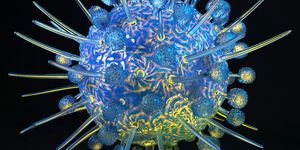Tiny parasitic hookworms infect nearly half a billion people worldwide, almost exclusively in developing countries. Researchers say sequencing the genome of a particular species could help develop more effective drugs.
Medicines have been developed to treat hookworm infections that cause health problems such as gastrointestinal issues, cognitive impairment, and stunted growth in children-but the parasites have begun to develop resistance to the drugs.

Other hookworm species cause more disease among humans, but Ancylostoma ceylanicum piqued researchers' interest because it also infects some species of rodents that are commonly used for research, which means their entire infection process can be studied inside the laboratory.
30,000 genes
"Hookworms infect a huge percentage of the human population. Getting clean water and sanitation to the most affected regions would help to ameliorate hookworms and a number of other parasites, but since these are big, complicated challenges that are difficult to address, we need to also be working on drugs to treat them," says Paul Sternberg, professor of biology at California Institute of Technology and lead author of a new study in Nature Genetics.
For the study, researchers began by sequencing all 313 million nucleotides of the A. ceylanicum genome using next-generation sequencing in which a large amount of DNA is first reproduced as many very short sequences. Then, computer programs match up common sequences in the short strands to piece them into much longer strands.
The findings show that although the A. ceylanicum genome is only about 10 percent of the size of the human genome, it actually encodes at least 30 percent more genes-about 30,000 in total, compared to approximately 20,000-23,000 in the human genome.
Of these 30,000 genes, the essential genes that are turned on specifically when the parasite is wreaking havoc on its host are the most relevant to the development of potential drugs to fight the worm.
New family of proteins
The researchers wanted to learn more about those active genes, so they looked not to DNA but to RNA-the genetic material that is generated (or transcribed) from the DNA template of active genes and from which proteins are made.
Specifically, they examined the RNA generated in an A. ceylanicum worm during infection. Using this RNA, the team found more than 900 genes that are turned on only when the worm infects its host-including 90 genes that belong to a never-before-characterized family of proteins called activation-associated secreted protein related genes, or ASPRs.
"If you go back and look at other parasitic worms, you notice that they have these ASPRs as well," Sternberg says. "So basically we found this new family of proteins that are unique to parasitic worms, and they are related to this early infection process."
Since the worm secretes these ASPR proteins early in the infection, the researchers think that these proteins might block the host's initial immune response-preventing the host's blood from clotting and ensuring a free-flowing food source for the blood-sucking parasite.
Parasite balance
If ASPRs are necessary for this parasite to invade the host, then a drug that targets and destroys the proteins could one day be used to fight the parasite. Unfortunately, however, it is probably not that simple.
"If we have 90 of these ASPRs, it might be that a drug would get rid of just a few of them and stop the infection, but maybe you'd have to get rid of all 90 of them for it to work. And that's a problem," Steinberg says. "It's going to take a lot more careful study to understand the functions of these ASPRs so we can target the ones that are key regulatory molecules."
Drugs that target ASPRs might one day be used to treat these parasitic infections, but these proteins also hold the potential for anti-A. ceylanicum vaccines-which would prevent these parasites from infecting a host in the first place.
For example, if a person were injected with an ASPR protein vaccine before traveling to an infection-prone region, their immune system might be more prepared to successfully fend off an infection.
"A parasitic infection is a balance between the parasites trying to suppress the immune system and the host trying to attack the parasite," says Sternberg. "And we hope that by analyzing the genome, we can uncover clues that might help us alter that balance in favor of the host."
Researchers from Cornell University and UC San Diego contributed to the study. The National Institutes of Health and the Howard Hughes Medical Institute funded the work.
(Source: Jessica Stoller-Conrad - Caltech)









